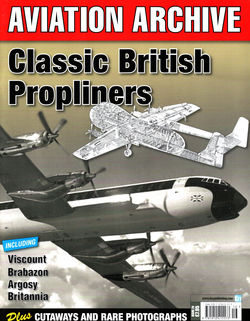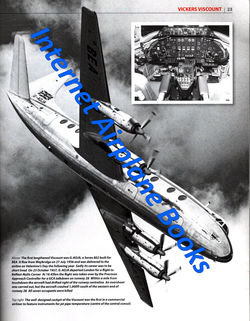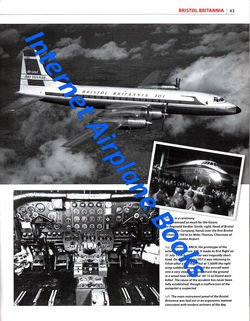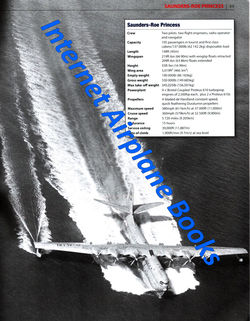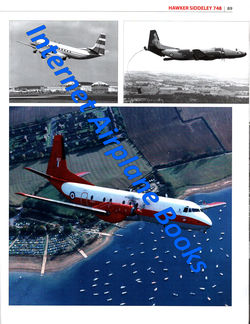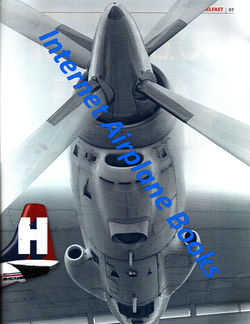CLASSIC BRITISH PROPLINERS VICKERS BRISTOL AIRSPEED DH
SAUNDERS ROE AW HP SHORTS HS SCOTTISH AVIATION TWIN PIONEER
SOFTBOUND BOOK FEATURING CUTAWAY
DRAWINGS, COLOR PROFILES AND RARELY SEEN IMAGES
BRISTOL FREIGHTER
HANDLEY PAGE HERMES
AIRSPEED AMBASSADOR
VICKERS VISCOUNT
BRISTOL BRABAZON
DE HAVILLAND HERON
BRISTOL BRITANNIA
SAUNDERS ROE PRINCESS
SCOTTISH AVIATION TWIN PIONEER
HANDLEY PAGE HERALD
ARMSTRONG WHITWORTH ARGOSY
VICKERS VANGUARD
HAWKER SIDDELEY 748
SHORTS SKYVAN
SHORTS BELFAST
-----------------------------------------------------------------------------------------
Additional Information from
Internet Encyclopedia
The Bristol Type 175 Britannia
was a British medium-to-long-range airliner built by the Bristol Aeroplane
Company in 1952 to fly across the British Empire. During development two
prototypes were lost and the turboprop engines proved susceptible to inlet icing
which delayed entry into service while solutions were sought.
By the time development was
completed, "pure" jet airliners from France, United Kingdom and the
United States were about to enter service, and consequently, only 85 Britannias
were built before production ended in 1960. Nevertheless, the Britannia is considered
one of the landmarks in turboprop-powered airliner design and was popular with
passengers. It became known by the title of "The Whispering Giant"
for its quiet exterior noise and smooth flying, although the passenger interior
remained less tranquil.
Canadair purchased a licence to
build the Britannia in Canada, adding another 72 variants. These were the
stretched Canadair CL-44/Canadair CC-106 Yukon, and the greatly modified
Canadair CP-107 Argus patrol aircraft.
In 1942, during the Second World
War, Allied aircraft construction saw the UK of necessity concentrating on
heavy bombers, leaving the production of transport aircraft to the USA. This
would have left the UK with little experience in transport construction at the
end of the war, so in 1943, a committee under Lord Brabazon of Tara
investigated the future of the British civilian airliner market. The Brabazon
Committee called for several different aircraft to be developed to specifications
composed by the committee for roles felt to fulfil Britain's civilian aviation
needs.
Bristol won the Type I and Type
III contracts, delivering their Type I design, the Bristol Brabazon in 1949.
The requirement for the 1946 British Overseas Airways Corporation (BOAC) Medium
Range Empire (MRE) Requirements coincided with the Type III, Specification
C.2/47, issued in April 1947 by the Minister of Supply. The specifications
called for an airliner capable of carrying 48 passengers and powered with Bristol
Centaurus radial engines or Napier Nomad turbo-compound diesel engine.
Turboprop options were also considered, but they were so new that Bristol could
not guarantee the performance specifications.
Although in-company Proposals
"X" for conversions of Lockheed Constellations to Centaurus 662
powerplants or "Y" for licence production of the Constellation were
considered in late 1946, BOAC decided that an entirely new design was
preferred. After wrangling between the Ministry of Supply and BOAC over costs,
the go-ahead for the project assigned the company designation Model 175 was
given in July 1948. Three prototypes were ordered as Mk 1 (Centaurus 662), with
the second and third prototypes designated the Mk 2 (to be convertible to
Bristol Proteus turboprops, then under development).
In October 1947, with work
already underway, Bristol had settled on a Centaurus-powered design, with an
all-up weight of 103,000 lb (47,000 kg) and a payload of 13,300 lb (6,000 kg).
The anticipated Karachi-Cairo run necessitated a 48-seat limit with a
requirement for sufficient fuel for the lengthy stage. On 5 July 1949, the
Ministry of Supply ordered five prototypes to this specification with the
understanding that BOAC would contract for an additional 25 production
examples. BOAC purchased options for 25 aircraft on 28 July, to be powered initially
with the Bristol Centaurus engine but to be re-fitted with the Bristol Proteus
when available. In November 1948, the Type 175 design was revised again to
accommodate 74 passengers and a longer span wing in a contemplated long-range
version aimed at long-haul Empire and transatlantic routes rather than the
medium-haul Empire routes originally planned. On reflection, BOAC decided that
only a Proteus-engined aircraft was worth working on, necessitating a further
redesign with Bristol eliminating the Centaurus option. Senior figures within
BOAC such as the Deputy Chairman Whitney Straight, however, considered the
Proteus engine to be "an obsolete contraption". Despite BOAC's desire
to have a turboprop engine, the Type 175 project was contingent on the Proteus
passing a 150-hour Type Test.
Following a long period of
uneventful development flying trials and the fitting of a modified Proteus 765
series engine that greatly reduced breakdowns, a full Certificate of
Airworthiness was awarded at the end of 1955. The first two Model 102s were
delivered to BOAC on 30 December 1955 for crew training. The Model 102 began
scheduled service on 1 February 1957 with a BOAC flight from London to
Johannesburg, flights to Sydney following in March and to Tokyo in July. By
August 1957, the first 15 Model 102 aircraft had been delivered to BOAC. The
last 10 aircraft of the order were built as Series 300 aircraft for
transatlantic flights. In April 1959, a Model 102 Britannia was leased by BOAC
to Ghana Airways for flights between Accra and London, and several more
Britannias were purchased by the airline in the early 1960s. The Model 102 was
eventually made available to other BOAC associates, including Cathay Pacific,
Central Africa, East African, Nigeria and Malayan airlines.
The next production series was
based on the long-range, mixed passenger/freight Model 200 series that was
intended for civil airline use but ultimately Bristol offered the series to the
Royal Air Force (RAF) instead. The production series of three Model 252 and 20
Model 253 aircraft were purchased by RAF Transport Command in 1959, assigned
the designation Britannia C.2 (first Model 252 series) and C.1 (Model 253
series). Those in RAF service were allocated the names of stars, such as
"Arcturus", "Sirius" and "Vega". On retirement
from the RAF in 1975, many Model 200 series were subsequently used by
independent civil operators for cargo operations, harkening back to their
original intended role.
Although the Bristol Model 302
was built first as part of the original BOAC order, BOAC released this series
to other airlines; Aeronaves de Mexico took two Model 302s which entered
service in December 1957. The 18 Bristol Britannia 312s for BOAC were delivered
from September 1957 with its service introduction on the first-ever non-stop
flight from London to Canada on 19 December 1957. In late December 1957 BOAC
began regular Britannia flights from London to New York. Other airlines, such
as Israel's El Al used the Britannia on transatlantic routes. In 1959 BOAC started
flying the Britannia across the Pacific to Tokyo and Hong Kong, thus extending
their network round the world. The westbound routing in 1959 for these
intercontinental BOAC Britannia flights between the U.K. and Asia was
London-New York-San Francisco-Honolulu-Wake Island-Tokyo-Hong Kong.
On 1 April 1958 Canadian Pacific
Air Lines took delivery of the first of six Model 314 Britannias, with an
additional two Model 324s (built to a 320 standard) arriving later and sold to
Cathay Pacific in 1961. BOAC ordered seven Model 302s but never took delivery,
instead they were taken on by airlines including Aeronaves de México and Ghana
Airways. The main long-range series were the 310s, of which BOAC took 18 and,
after deliveries began in September 1957, put them into service between London
and New York; in March 1964 BOAC owned 50 aircraft, 10 being Britannia 312s.
BOAC's last scheduled Britannia flight was April 1965.
The 310 series (the Model 318)
also saw transatlantic service with Cubana de Aviación starting in 1958, in
spite of the Cuban Revolution the airline had a special accord with British
aircraft manufacturers to maintain this model of aircraft. In 1975 Cuban
Britannias were used to transport hundreds of soldiers of the Cuban
Revolutionary Armed Forces to Angola in Operation Carlota, a proxy war. Cubana
de Aviación continued using various Britannias until March 1990.
Most aircraft were built by
Bristol at Filton but 30 were built at Belfast by Short Brothers and Harland.
Due to the extended development instead of a projected production of 180
Britannias, only 80 were sold. The negative experience with the development of
the Britannia caused BOAC to be more cautious towards other British-made aircraft
such as the Vickers VC-10. Throughout the Britannia's lifespan, the engine
icing condition remained a "continual potential hazard" that flight
crews ultimately learned to manage with a "high-lo" flight regime
that minimized the danger, although the problems of the Britannia can mainly be
linked to that of a manufacturer undertaking an innovative airframe design
matched to an unproven engine, a design syndrome that remained particularly
daunting. Squadron Leader David Berry who had 5,000 hours on the type
characterised his experiences as flying "Beauty and the Beast." A
more fitting epitaph was recently proffered by the editors of Aeroplane as the
"100 Great British Aircraft" (2008) were analysed with the Bristol
Britannia counted among the "greats".
Following purchase of remaining
spare parts from Royal Aircraft Establishment and Cubana, Zaïrois airlines
continued to operate Bristol Britannia into the early 1990s on regular cargo
flights from N'djili Airport to various destinations within the country.
--------------------------------------------------------------------------------------------------------------
Additional
Information from Internet Encyclopedia
The
Handley Page Dart Herald was a 1950s British turboprop passenger aircraft.
In
the mid-1950s Handley Page developed a new fast short-range regional airliner,
intended to replace the venerable Douglas DC-3, particularly in third-world
countries. The design, originally known as the HPR-3 Herald, emanated from the
drawing office at Handley Page (Reading) Limited—the former Miles Aircraft
factory site, which had developed an earlier airliner design, the Miles
Marathon. The Herald was an extensive re-development of the original concept of
the Marathon, notable for its high mounted wing. The HP Reading division
succeeded in producing a modern design with excellent flight and performance
characteristics. However, the company made a serious misjudgement which was, in
the end, to cost the company dearly, and like some other classic British
aircraft of the time, the Herald missed its chance.
After
extensive consultation with DC-3 operators, it was decided to power the new
airliner with piston engines, rather than turboprops, which were considered
risky by the small airlines at which the HPR.3 was aimed. Handley Page
preferred a four-engined design, which led to the new 870 hp (650 kW) Alvis
Leonides Major 14-cylinder radial engine, driving three-bladed propellers being
chosen for the HPR.3. At almost the same time, the Dutch company Fokker made
the opposite choice for its competitor for the same market, choosing to power
the F27 Friendship with two Rolls-Royce Darts.
The
HPR.3 could carry up to 44 passengers in its pressurised cabin, which could be
quickly converted to allow the carrying of freight, with the aircraft's high
wing, nosewheel undercarriage and large doors at the front and rear of the
cabin making the loading of cargo relatively simple. Large flaps were fitted to
give good short takeoff and landing characteristics. It was designed to cruise
at a speed of 224 mph (360 km/h), had a range of 1,640 mi (2,640 km), could
land and take off in a distance of less than 500 yards (460 m) and had an
initial rate of climb of over 1,800 ft/min.
At
first, it seemed that Handley Page had made the right choices with the HPR.3,
which was named "Herald" in August 1954, this being a name easily
translatable into French and Spanish. Extensive work by the sales team had
produced considerable interest from potential customers, and Handley Page had
29 orders for the Herald (from Queensland Airlines, Australian National
Airways, and Lloyd Aéreo Colombiano) by the time the first prototype made its
maiden flight from Radlett on 25 August 1955, three months ahead of the first
flight of the Friendship. Break-even was expected after the sale of 75 aircraft
and Handley Page expected total sales of up to 300 Heralds, with first
deliveries expected to British independent airline Air Kruise in 1958.
By
now, however, the Rolls-Royce Dart turboprop engine had shown proven success in
the Vickers Viscount. Queensland Airlines and Australian National Airways
cancelled their orders for Heralds in favour of turboprop-powered Friendships,
while the Lloyd Aéreo Colombiano contract was stopped due to currency problems
and Air Kruise's interest was ended when it was taken over by British Aviation
Services. Before the second prototype had been completed, Handley Page was
faced with the fact that it had no orders for the Herald, and that the market
had changed and wanted turboprops.
There
had already been a very substantial investment in the Herald project, such that
the management held a meeting to discuss continuation. Handley Page decided to
press ahead with the Herald project, in an effort to recover the investment;
announcing a new uprated version powered by the Rolls-Royce Dart. The revised
aircraft, now designated the HPR.7 Dart Herald, was powered by 1,910 shp Dart
527 engines driving 12 ft 6 in (3.81 m) variable pitch four-blade Dowty Rotol
propellers, and the fuselage was lengthened by 20 in (51 cm), while other
improvements included increased fuel capacity. The first prototype was
converted to Dart Herald standard, making its maiden flight on 11 March 1958,
with the first production aircraft flying on 30 October 1959. The initial
Series 100 version of the Dart Herald was certified in April 1958.The basic price
in 1960 was around £185,000.
--------------------------------------------------------------------------------------------------------------
Additional
Information from Internet Encyclopedia
The
Vickers Viscount was a British medium-range turboprop airliner first flown in
1948 by Vickers-Armstrongs, the first such aircraft to enter service in the
world. A product of the Brabazon Committee, it used a new form of propulsion,
the turboprop engine, replacing the conventional piston engine.
The
Viscount was well received by the public for its cabin conditions, which
included pressurisation, reductions in vibration and noise, and panoramic
windows. It became one of the most successful and profitable of the first
post-war transport aircraft; 445 Viscounts were built for a range of
international customers, including in North America.
The
Viscount was a response to the Brabazon Committee's Type II design for a
post-war small medium-range pressurised aircraft to fly less-travelled routes,
carrying 24 passengers up to 1,750 mi (2,816 km) at 200 mph (320 km/h). During
discussions between the committee and Vickers' chief designer, Rex Pierson,
Vickers advocated turboprop power. The committee was not convinced and split
the specification into two types, the Type IIA using piston power, which led to
the Airspeed Ambassador, and the turboprop-powered Type IIB which Vickers was
selected to develop in April 1945. British European Airways (BEA) was involved
in the design and asked that the aircraft carry 32 passengers instead, but
remained otherwise similar.
The
first design in June 1945 was based on the Viking with four turboprop engines
and 24 seats and designated the VC-2 or Type 453. Later a double-bubble
fuselage was proposed to give extra underfloor cargo space. Neither was
pressurised but it was soon realised that for economical operation an altitude
above 20,000 ft (6,100 m) was needed. Thus pressurisation was required. The
decision for pressurisation resulted in the double-bubble and elliptical
fuselage designs being abandoned. A circular cross-section variant was offered
at the beginning of 1946. The resulting 28-seat VC-2 was financed by the
Ministry of Supply with an order for two prototypes. But, before the contract
was signed, the government asked for the capacity to be increased to 32. This
stretched the fuselage increase from 65 ft 5 in (19.94 m) to 74 ft 6 in (22.71
m) and meant an increased wingspan of 89 ft (27 m).
The
contract for the aircraft to Air Ministry specification C.16/46 was signed on 9
March 1946 and Vickers allocated the designation Type 609 and the name Viceroy.
Although George Edwards had always favoured the 800 hp Rolls-Royce Dart other
engines were considered, including the Armstrong Siddeley Mamba which the
government specified for the two prototypes. The choice of the Mamba engine
increased the weight but Vickers made sure the engine nacelle would fit either
the Mamba or Dart. While the Dart progressed better in development, the
government asked in August 1947 for the second prototype to be Dart-powered.
The second prototype was designated the 630 and was named as the Viscount. The
first prototype already under construction was converted to the Dart as a 630
as well.
The
resulting Vickers Type 630 design was completed at Brooklands by chief designer
Rex Pierson and his staff in 1945, a 32-seat airliner powered by four Dart
engines for a cruising speed of 275 mph (443 km/h). An order for two prototypes
was placed in March 1946, and construction started in the company's Foxwarren
Experimental Department. Originally Viceroy after the viceroy of India, Lord
Louis Mountbatten, the aircraft was renamed Viscount following India's
independence in 1947.[9] There was work on replacing the Darts with the Mamba,
but this was dropped by the time the prototypes were reaching completion. After
Pierson's death in 1948, George Edwards (later Sir George Edwards) took over as
chief designer and assumed all technical control over the Viscount project.



